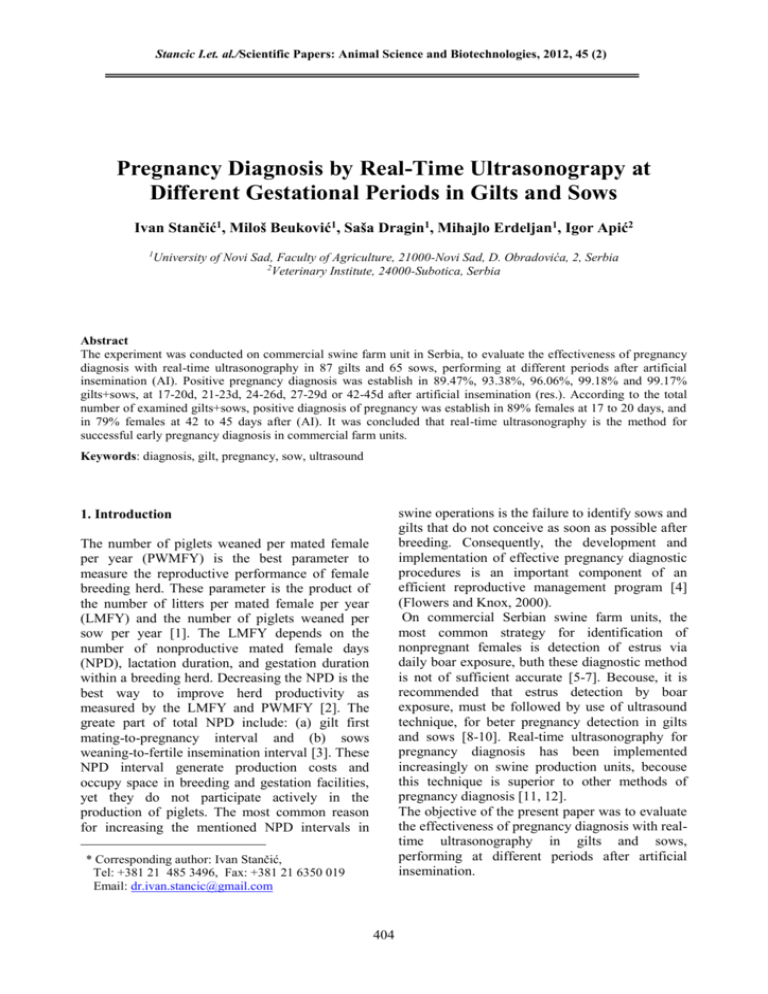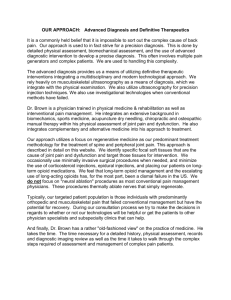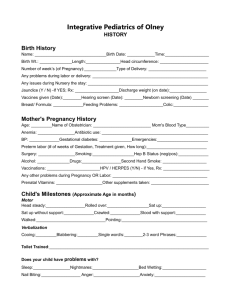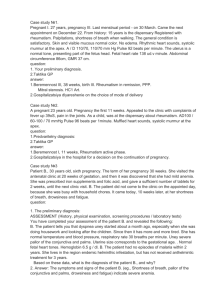Preliminary researches on the effect of essential oils on moulds
advertisement

Stancic I.et. al./Scientific Papers: Animal Science and Biotechnologies, 2012, 45 (2) Pregnancy Diagnosis by Real-Time Ultrasonograpy at Different Gestational Periods in Gilts and Sows Ivan Stančić1, Miloš Beuković1, Saša Dragin1, Mihajlo Erdeljan1, Igor Apić2 University of Novi Sad, Faculty of Agriculture, 21000-Novi Sad, D. Obradovića, 2, Serbia 2 Veterinary Institute, 24000-Subotica, Serbia 1 Abstract The experiment was conducted on commercial swine farm unit in Serbia, to evaluate the effectiveness of pregnancy diagnosis with real-time ultrasonography in 87 gilts and 65 sows, performing at different periods after artificial insemination (AI). Positive pregnancy diagnosis was establish in 89.47%, 93.38%, 96.06%, 99.18% and 99.17% gilts+sows, at 17-20d, 21-23d, 24-26d, 27-29d or 42-45d after artificial insemination (res.). According to the total number of examined gilts+sows, positive diagnosis of pregnancy was establish in 89% females at 17 to 20 days, and in 79% females at 42 to 45 days after (AI). It was concluded that real-time ultrasonography is the method for successful early pregnancy diagnosis in commercial farm units. Keywords: diagnosis, gilt, pregnancy, sow, ultrasound 1. Introduction swine operations is the failure to identify sows and gilts that do not conceive as soon as possible after breeding. Consequently, the development and implementation of effective pregnancy diagnostic procedures is an important component of an efficient reproductive management program [4] (Flowers and Knox, 2000). On commercial Serbian swine farm units, the most common strategy for identification of nonpregnant females is detection of estrus via daily boar exposure, buth these diagnostic method is not of sufficient accurate [5-7]. Becouse, it is recommended that estrus detection by boar exposure, must be followed by use of ultrasound technique, for beter pregnancy detection in gilts and sows [8-10]. Real-time ultrasonography for pregnancy diagnosis has been implemented increasingly on swine production units, becouse this technique is superior to other methods of pregnancy diagnosis [11, 12]. The objective of the present paper was to evaluate the effectiveness of pregnancy diagnosis with realtime ultrasonography in gilts and sows, performing at different periods after artificial insemination. The number of piglets weaned per mated female per year (PWMFY) is the best parameter to measure the reproductive performance of female breeding herd. These parameter is the product of the number of litters per mated female per year (LMFY) and the number of piglets weaned per sow per year [1]. The LMFY depends on the number of nonproductive mated female days (NPD), lactation duration, and gestation duration within a breeding herd. Decreasing the NPD is the best way to improve herd productivity as measured by the LMFY and PWMFY [2]. The greate part of total NPD include: (a) gilt first mating-to-pregnancy interval and (b) sows weaning-to-fertile insemination interval [3]. These NPD interval generate production costs and occupy space in breeding and gestation facilities, yet they do not participate actively in the production of piglets. The most common reason for increasing the mentioned NPD intervals in * Corresponding author: Ivan Stančić, Tel: +381 21 485 3496, Fax: +381 21 6350 019 Email: dr.ivan.stancic@gmail.com 404 Stancic I.et. al./Scientific Papers: Animal Science and Biotechnologies, 2012, 45 (2) were AI 12h, and reinseminated 24h after standing estrus detection, within 7 days after weaning. Insemination doses for gilts and sows containe 5x109 viable spermatozoa in 100 ml of Beltsville Thawing Solution semen extender (BTS). 2. Materials and methods Transabdominal real-time (B-mode) ultrasonography was performed for pregnancy diagnosis in 87 gilts and 65 sows, at 17-20, 21-23, 24-26, 27-29 or 42-45 days after previous artificial insemination (AI). Diagnosis were performed by Mindray DP6600 real-time (B-mode) machine and convex 3,5 MHz transabdominal transducer. Eighty-seven gilts, that had exhibited at least one estrous cycle of normal length (18 to 24 days), were AI once each day of estrus. Sixtu-five sows 3. Results and discussion The proportion of pregnancy real-time ultrasonography established at different period after artificial insemination are shown in Table 1. Table 1. Positive pregnancy ultrasound diagnosis established at different gestational periods Days of gestation* 17 - 20 21 - 23 24 - 26 27 - 29 Total examined n 87 78 72 69 Glits n 78 72 69 68 Positive diagnose % 89.65 92.31 95.83 98.55 Total examined n 65 58 55 53 Sows n 58 55 53 53 Positive diagnose % 89.23 94.83 96.36 100.0 Total examined n 152 136 127 122 Gilts + Sows n 136 127 122 121 Positive diagnose % 89.47 93.38 96.06 99.18 *Days after previous insemination. The level of estimated pozitive pregnancy diagnosis were similar in gilts and sows at the same period of detection after artificial insemination, ranged from aprocsimately 89.5%, at 17-20 days to more than 98% at 42-45 days after previous insemination. 42 - 45 68 67 98.55 53 53 100.0 121 120 99.17 According to the total number of examinated gilts and sows, the proportion of gilts and sows diagnosed as pregnat decrease from average 89.5% at 17-20 days, to 78.9% at 42-45 days after AI. These decreasing were slowly higher in the gilt (from 89.6% to 77%) then in the sows (from 89.2% to 81.5%) (Tabele 2 and Figure 1). Pregnant / total number (%) Table 2. Reduction of positive diagnose according to total gilts and sows examinated (%) Days of gestation 17 - 20 21 - 23 24 - 26 27 - 29 42 - 45 Gilts 89.6 (78/87) 82.8 (72/87) 79.3 (69/87) 78.2 (68/87) 77.0 (67/87) Sows 89.2 (58/65) 81.5 (53/65) 81.5 (53/65) 81.5 (53/65) 81.5 (53/65) Gilts + Sows 89.5 (136/152) 83.5 (127/152) 80.3 (122/152) 79.6 (121/152) 78.9 (120/152) 90 89 89 89 AI - USD (days) 17-20 42-45 85 81 80 79 77 75 70 Gilts Sows Total Figure 1. Percentage decreasing of gilts and sows ultrasound diagnosed (USD) as pregnant from 17 - 20 to 42 - 45 days after artificial insemination (AI) 405 Stancic I.et. al./Scientific Papers: Animal Science and Biotechnologies, 2012, 45 (2) In our experiment, positive pregnancy diagnosis were establish in 89.5% from the total number of gilts and sows examined at 17-20 days (136/152) and in 99.2% of gilts and sows examined at 42-45 days after AI, calculated from the number of females that were detected as pregnant at 27-29 days after AI (120/152). Buth, according to the total number of examined gilts and sows, diagnosed as pregnant at 17-20 days after AI, positive diagnosis were reconfirmed in 78.9% (120/152) females, at 42-45 days after AI. Williams et al. (2008) was scanned 142 sows for pregnancy diagnosis between 17 and 24 days postmating (PD1) and reconfirmed between 38 and 45 days of gestation (PD2). Accuracy between PD1 and PD2 was 80.6%. The proportion of correct positive diagnosis (accuracy) increase from 57%, at 18 days after AI, to 96.2% at 24 days after AI [13]. Pregnancy diagnosis in sows using transabdominal ultrasound testing can be assessed quickly and reliably under field conditions, from day 23 of gestation onwards. Buth, predictive values of positive test results is high, whereas those of negative test results is low. This implies that sows with a negative test result early in pregnancy should be retested later [14]. Early and accurate diagnosis of nonpregnant sows and gilts has the potential to increase reproductive efficiency and the financial income in pig production by reducing non-productive days per sow per year [12]. Furthermore, in recent years, real-time (B-mode) ultrasonography has found increased application in its use for monitoring ovarian activity and in estimating time of ovulation in pigs. B-mode ultrasonography is also valuable in providing a detailed assessment of the sow’s ovaries and uterus to determine if pathological conditions exist, which could be contributing to poor individual or herd reproductive performance [15]. In its most recent application in pigs, the gilt genital tract has been characterized peripubertally by ultrasonography in order to detect onset of puberty [7, 16]. from average 89.5% at 17-20 days to 99.2% at 4245 days after AI. 2. According to the total number of examined gilts and sows, the confirmed positive pregnancy diagnosis decrease from 89.5% at 17-20 days to 78.9% at 42-45 days after AI. 3. Real-time ultrasonography can be used with a high degree of effectiveness for pregnancy diagnosis on swine production units. References 1. Dial, G.D., Marsh, W.E., Polson, D.D., Vaillancourt, J. P., Reproductive failure: Differential diagnosis (pp. 88-137), In: Diseases of Swine. 7th ed., 2. Leman, A.L., Straw, B.E., Mengeling, W.L., D’Allaire S., Taylor D.J., ed. Iowa State Univ. Press, Ames, 1992. 3. Wilson, M.R., Friendship, R.M., McMillan, I., Hacker, 3.R.R., Piper, R., Swaminathan, S., A survey of productivity and its component interrelationships in Canadian swine herds, J. Anim. Sci., 1986, 62, 576– 582. 4. Koketsu, Y., Six component intervals of nonproductive days by breeding-female pigs oncommercial farms, J. Anim. Sci., 2005, 83, 14061412. 5. Flowers, L.W., Knox, V.R., Pregnancy Diagnosis in Swine, Porc. Information Getaway, PIH-143, 2000, pp.1-9. 6. Stančić, B., Zvekić, D., Popov Radmila, Radović, I.: Vrednost prašenja krmača prirodno ili veštački osemenjenih u prvom postlaktacijskom estrusu, Letopis naučnih radova, Poljoprivredni fakultet, Novi Sad, 2003, 27, 1, 51-55. 7. Stančić, I., Gagrčin, M., Anderson, R., Harvey, R., Stančić, B., Radović, I., Božić, A., Prolongirana preinseminaciona anestrija nazimica, Savremena poljoprivreda, 2008, 57, 3-4, 97-105. 8. Stančić, I., Stančić, B., Božić, A., Anderson, R., Hervey, R., Gvozdić, D., Ovarian activity and uterus organometry in delayed puberty gilts, Theriogenology, 2011, 76, 1022-1026. 9. Knox, R., Flowers, W., Using Real-Time Ultrasound for Pregnancy Diagnosis in Swine. Pork Industry Handbook, 2004, pp. 30-37. 10. Miller, G.M., Breen, S.M., Roth, S.L., Willenburg, K.L., Rodriguez-Zas, S., Knox , R.V., Characterization of image and labor requirements for positive pregnancy diagnosis in swine using two methods of real-time ultrasound, J. Swine Health Prod., 2003, 11, 5, 233239. 11. Williams, I.S., Piñeyro, P.P, De la Sota, L.R., Accuracy of pregnancy diagnosis in swine by ultrasonography, Can. Vet. J., 2008, 49, 3, 269–273. 4. Conclusions Based on our results, it can be conclude: 1. The positive pregnancy diagnosis by real-time ultrasonography in gilts and sows were increase 406 Stancic I.et. al./Scientific Papers: Animal Science and Biotechnologies, 2012, 45 (2) Kyriazakis, I., Whittemore, T.C., Pregnancy diagnosis (pp.145-146), In: Whittemore’s Science and Practice of Pig Production. Blackwell Publishing Ltd, Oxford, UK, 2006. 12. Kauffold, J., Althouse, G., Beynon, N., Ultrasound scanning – more than just pregnancy testing, Prairie Swine Centre, 2011, 1-4. Flowers, L.W., Armstrong, D.J., White, S.L., Woodard, 13. Almond, O.T., Real-time ultrasonography and pregnancy diagnosis in swine, Proc. American Society of Animal Science, 1999, pp. 1-9. 14. Maes, D., Dewulf, J., Vanderhaeghe, C., Claerebout, K., de Kruif, A., Accuracy of trans- abdominal ultrasound pregnancy diagnosis in sows using a linear or sector probe, Reprod. Domest. Anim., 2006, 41, 5, 438-43. 15. Waberski, D., Kunz-Schmidt, A., Borchardt Neto, G., Richter, L., Weitze, F.K., Real-time ultrasound diagnosis of ovulation and ovarian cysts in sows and its impact on artificial insemination efficiency, Proc. American Society of Animal Science, 1999, 1-8. 16. Kauffold, J., Althouse, C.G., An update on the use of B-mode ultrasonography in female pig reproduction (a review), Theriogenology, 2007, 67, 901–911. 407






